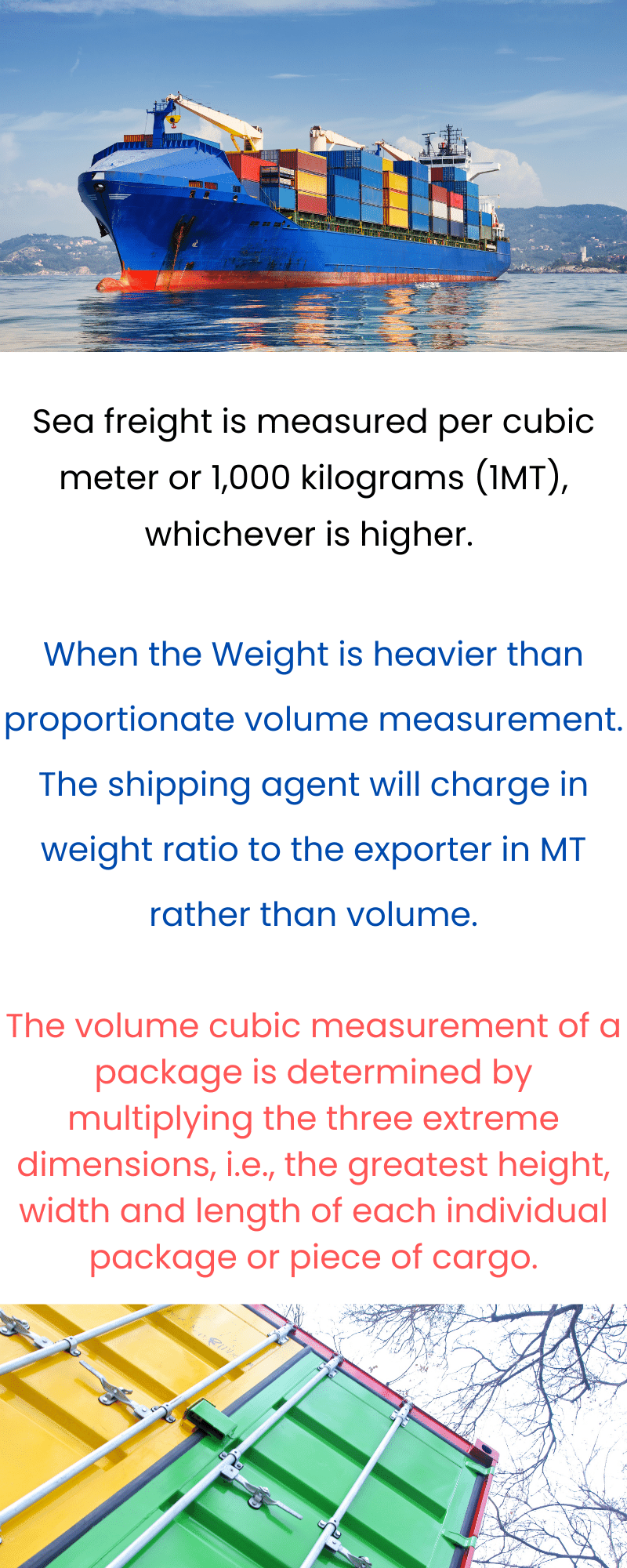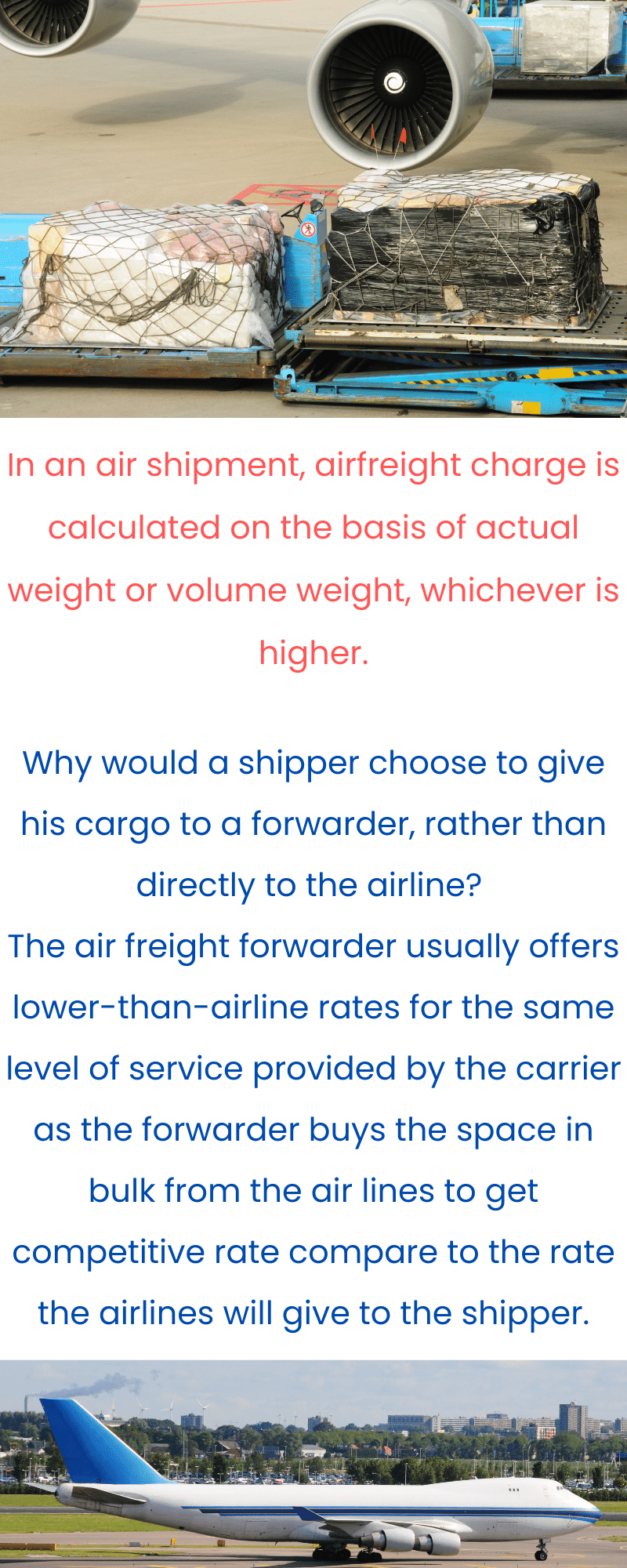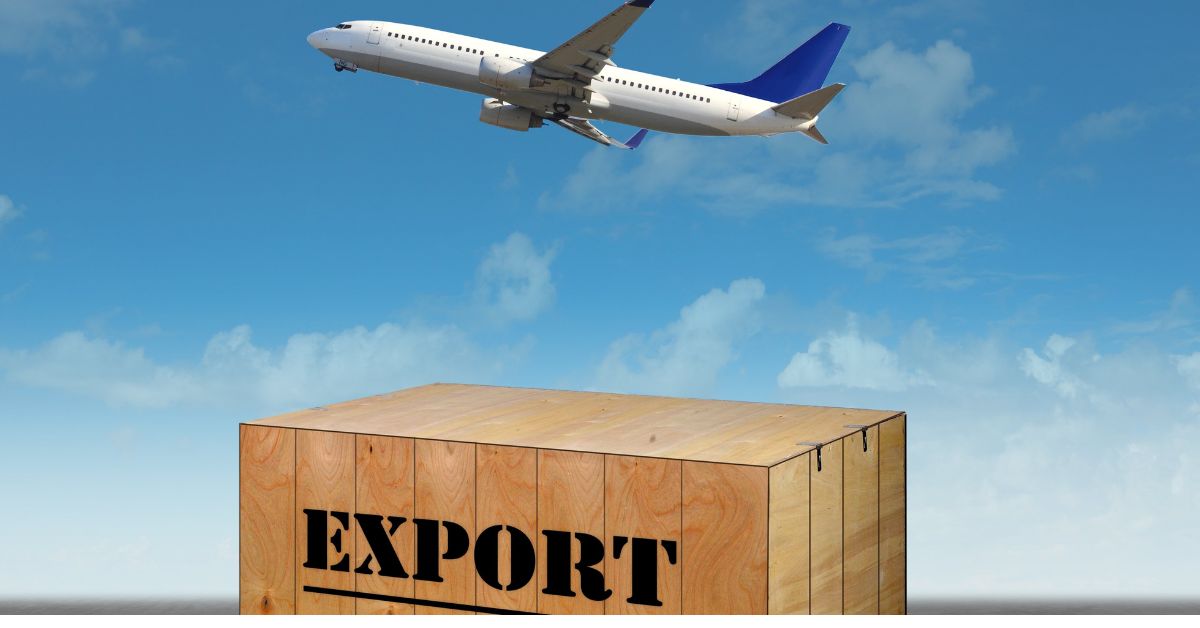Let us know the process to calculate the total cost of Sea & Air Freight in Export:
Table of Contents
Sea Freight
Sea freight is measured per cubic meter or 1,000 kilograms (1MT), whichever is higher.
In sea freight most general cargo tends to pay freight by the volume but calculating the weight/volume ratio is an important factor in export goods.
For example, when you export heavy metals in containers the weight is heavier than proportionate volume measurement. So the shipping agent will charge in weight ratio to the supplier in MT rather than volume.
The volume cubic measurement of a package is determined by multiplying the three extreme dimensions, i.e., the greatest height, width and length of each individual package or piece of cargo.
An exporter or importer when needs to ship goods, reaches out to shipping agent/freight forwarder to know the freight rates to export the goods.
Let us see how a freight forwarder does the costing analysis in sales to the individual exporter or importer.
The freight forwarder buys the space at a “wholesale” price form the shipping & air lines and sells it at a “retail” price. This applies to FCL shipments as well as to LCL shipments handed over to a consolidator.
In addition to the freight charges there are other charges an importer or exporter has to pay to the freight forwarder for performing services related to the movement of the goods like:
- Stuffing and de-stuffing
- Local cartage
- Packaging
- Services that are a regular part of a shipment, such as documentation preparation, HBL fees, etc.
Apart from the above costs other services you can take from a freight forwarder and the cost can include like:
- Marine insurance
- Warehousing
- Packaging
- Customs brokerage.
Let us see how per Metric Ton (MT) rates are given to traders from shipping agent for a 40ft std. container in Metric Ton (MT) where Weight is higher than proportionate Volume:
| Items | Rates in $ |
| Ocean Freight(40ft std. Cont) | $ 1,000.00 |
| Empty pickup | $ 100.00 |
| Loading | $ 300.00 |
| Dunnage Material | $ 30.00 |
| Total Cost | $ 1,430.00 |
| Freight forwarder’s profit margin | $ 200.00 |
| Total(Cost+Profit) | $ 1,630.00 |
| Average Capacity of 40ft std. Cont in Tons(MT) | 50 MT |
| Average Rate per MT | $ 33 |
The importer or exporter buys the $33/MT rate from the freight forwarder to ship the goods from the origin to the destination.
If the volume of the goods is higher than the proportionate weight then the rates are given in CBM.
For example in the export of the garments, the volume is way higher than the weight. Then the rate is given in CBM.
| Items | Rates in $ |
| Ocean Freight(40ft std. Cont) | $ 1,000.00 |
| Empty pickup | $ 100.00 |
| Loading | $ 300.00 |
| Dunnage Material | $ 30.00 |
| Total Cost | $ 1,430.00 |
| Freight forwarder’s profit margin | $ 200.00 |
| Total(Cost+Profit) | $ 1,630.00 |
| Average Volume in CBM | 54 |
| Average Rate per CBM | $30 |
The importer or exporter buys the $30/CBM rate from the freight forwarder to ship the goods from the origin to the destination.
Air Freight
In air freight, it is 1 kg/6,000 cm3, whichever is higher.
In an air shipment, airfreight charge is calculated on the basis of actual weight or volume weight, whichever is higher.
So how do we determine which weight will be charged, which will be the chargeable weight?
Let us explain with an example.
If a shipper exports cotton, the actual weight of cotton is very low but occupies a large amount of space as a volume. In this case, if airfreight is charges on the basis of actual weight of cargo, the said shipper needs to pay a very nominal airfreight compared to a shipper who exports iron plates.
So here the importance of volume weight arises by considering volume of cargo and actual weight of cargo at an equilibrium point.
It is to be noted that in order to find volume weight of cargo you need to have measurement of package of goods. If the cargo measurement are in centimeters, the total volume of cm3 to be divided with 6000.
If the volume is in cubic meter (CBM), the said volume in m3 to be divided with 0.006.
Air carriers charge airfreight on the basis of volume weight or actual gross weight whichever is higher.
Shipment 1:
Gross weight =700kgs
Measurement of cargo = 150cm X 100cm X 116cm = 1 box
88cm X 67cm X 113cm = 3 boxes
Total volume = 1740000+(666248X3) = 3738744 cubic centimeter
Total volume weight = 3738744 / 6000 = 623.124kgs
Here in shipment No: 1, the gross weight is 700kgs and volume weight is 623.124kgs. Hence, Chargeable weight is 700 kgs which is also gross weight, 700kgs (which is greater)
Shipment 2:
Gross weight = 600kgs
Measurement of cargo = 100cm X 110cm X 105cm = 4 boxes
Total volume = 4620000 cubic centimeter
Total volume weight = 4620000 / 6000 = 770kgs
Here in shipment No:2, the gross weight is 600kgs and volume weight is 770kgs. Hence, airfreight is charged on the basis of volume weight, 770kgs. Here, the chargeable weight is 770kgs.
Why would a shipper choose to give his cargo to a forwarder, rather than directly to the airline?
Shipper does so because he is better off, in terms of both rate and service he is getting from the forwarder, doing it this way.
The principles we discussed in ocean freight consolidations apply as well in air cargo movements. The forwarder is a large client to the airline, whereas Citizen Y is likely not! Citizen Y’s cargo may well be left on the station to make room for the box belonging to the air freight forwarder, the regular client.
The air freight forwarder usually offers lower-than-airline rates for the same level of service provided by the carrier as the forwarder buys the space in bulk from the air lines to get competitive rate compare to the rate the airlines will give to the shipper.


